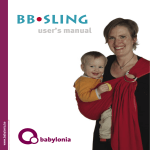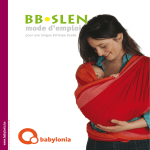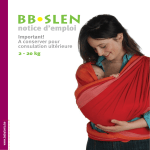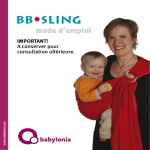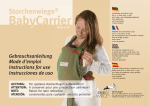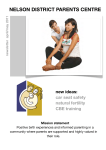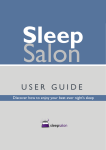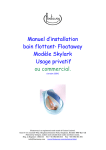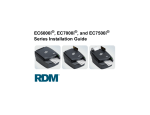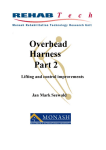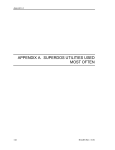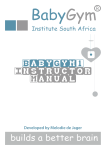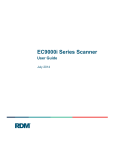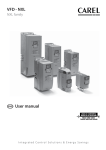Download BB•SLEN - Boobs-`n
Transcript
BB•SLEN user’s manual www.babylonia.be for a long woven scarf > CONGRATULATIONS! You have chosen to carry your baby in a cloth baby carrier. Babies across the globe are carried by their parents, siblings, and caregivers as they continue through their daily activities. A practice which benefits both the baby and the wearer as you will see. Before providing you with step-by-step instructions on how to tie your baby carrier, we first want to explain why you should carry your baby. Take your time and read through the manual calmly. You do not have to become an expert in all the positions presented. Besides, not every baby will like every position. We present you with a large variety so that you and your baby can try them out and choose your favorites. Worn up next to you, your baby can participate in your activities. This interaction with the outside world will enhance his language and social development. Learning to carry your baby comfortably is like learning to dance. It takes a little practice before the movements become second nature and you glide through them with your eyes closed. It is often helpful to practice tying the scarf several times before placing your baby inside. It can also help to talk to your baby and explain what you are doing while placing him in the carrier. Your baby will sense if you are uncomfortable. Tell him you are a bit insecure yourself but that you will learn how to do this together. You will see, once you have learned to carry your baby, you will wonder how you ever lived without it. Not only does it make life easier, it provides sensory and motor development and much more. Table of Contents Introduction 3 Frequently Asked Questions 4 How to Choose a Position 6 (and pages references to each individual method) Getting Started 8 Tying Methods 10 Twins 44 Other Babylonia Products & Thank You 47 © copyright Babylonia 2005 This book, or parts thereof, may not be reproduced in any form without permission. Want to read more about the benefits of carrying your baby? Here are a few of our favorites. BB•SLEN > User’s Manual Please read through carefully before starting! Granju, Katie Allison. Attachment Parenting: Instinctive care for your baby and young child. New York, New York: Pocket Books, 1999. Heller, Sharon. The Vital Touch: How Intimate Contact with Your Baby Leads to Happier, Healthier Development. New York, New York: Henry Holt and Company, 1997. Liedloff, Jane. The Continuum Concept: In search of happiness lost. Cambridge, Massachussetts: Perseus Books, 1985. Sears, W. and Sears, M. The Attachment Parenting Book. Boston, Massachusetts: Little Brown, 2001. Small, Meredith F. Our Babies, Ourselves: How Biology and Culture Shape the Way We Parent. New York, New York: Doubleday, 2001. Babies Yearn for Skin After nine months of warmth, movement and constant contact with mother, birth is a huge transition and babies are in need of intimate contact with their parents. Babies who are carried close to the body, visibly enjoy this direct physical contact. The cherishing body-to-body contact fulfils one of baby’s primal and deep needs and offers an ideal position from which to discover the big wide world. Safe and Secure In a simple cloth carrier, your baby feels safe and secure. He feels your physical warmth and hears your voice and heartbeat. He recognizes your scent and can have permanent eye contact with you. Babies Cry Less Research indicates that babies who are carried on a daily basis cry significantly less. In a cloth carrier your baby is not forced to passively spend the day. He participates naturally in your daily activities. Hence, your baby can observe and hear quite a bit, which is beneficial for his psychosocial development. When he has had enough, your baby simply closes his eyes and falls asleep on your chest. Stimulates balanced development In the security of a cloth sling, your baby experiences the world from a safe position. The huge amount of stimuli he has to deal with in a brief period of time does not frighten him because he is so close to you. This feeling of security results in the development of a positive self-image and later on, it forms the basis of a confident and assured personality. Contrary to old popular belief, it has become quite clear that carrying your baby in a cloth carrier does not lead to spoiled and dependent children, but that the opposite is accomplished. When using a baby carrier that is adapted to the wearer as well as the baby, it is possible to carry a child as long as he wishes. Children who are 2, 3, 4 or even 5 years old often get tired of walking and will ask to be carried. Holding a child of this age in your arms can put a lot of strain on one’s shoulders and back. A baby carrier, however, will distribute the weight of the child evenly. As a child progressively gains his independence, he will go back and forth between wanting to do it all by himself, and wanting help from others. Contrary to popular belief, meeting his needs and reassuring him will boost his confidence and make him more independent. And the father During the first few months it is not always easy for a young father to develop an equally close bond with baby as the mother. However, with a cloth carrier, he can undertake a lot of things at a very early stage with the baby safely tucked on his chest. FREQUENTLY ASKED QUESTIONS Is this type of carrier safe for the development of my baby’s spine? The basis of good posture begins with the pelvis. If this is well supported, the baby’s spine and neck will fall into a natural curve and the weight will be supported by the pelvis. To ensure a correct position, the baby’s knees should be higher than his pelvis, in a fetal position, with his hips and legs properly supported. The baby’s bottom should be lower than the knees and his back should be rounded with his head resting on your body. This is the ideal position for the development of healthy hip joints. The baby does not hang, but comfortably rests against the wearer. Will the carrier put too much pressure on my breasts? If you follow the instructions of our tying methods, the scarf should not put pressure on your breasts. You should cross the bands over or under them, and if across them, spread out the fabric so that it doesn’t put pressure on one specific spot. At what age can I start carrying my baby and when should I stop? The benefits of carrying premature babies – or kangaroo care – is well documented. A baby (full term or premature) can be placed in a baby carrier just after birth, creating a ‘womb with a view’. There are, of course, no problems starting later as well. Your back will strengthen If the baby is in an upright position, it is essential that the legs do not dangle or hang in mid-air. This puts strain on the baby’s spine and the baby will tend to arch backwards creating a bad position for his neck too. The fetal tuck is the most natural position for a baby. Not only is this position good for correct spinal and hip development, it allows him to rest and use his energy to develop other strengths. Does my baby’s head need to be supported? If your baby’s pelvis is supported correctly as explained above, then her neck will follow a natural curve and her head will rest on your chest. She is free to lift her head when curious to look around and her neck muscles will strengthen quickly. There is no need to support her head, unless you are bending over. At that moment, spread one band over her head. This can also be done to stabilize her when she is sleeping. How long can I safely carry my baby per day? There are no limits. A baby well positioned in a baby carrier can be carried as long as he and the wearer desire. Remember that babies around the world are carried throughout the entire day as the wearer continues about his or her daily tasks and activities. Is this good for my own back? If you have back problems, you should always consult with your doctor before using a baby carrier. This said, using a carrier is probably one of the best ways to prevent back strain because the cloth carries the weight and not your arms and back as when you are simply holding your baby in your arms. Carry your baby each day and progressively extend the carrying time to allow your back muscles a chance to strengthen along with the baby’s weight gain. as you carry your baby and his weight gains will go mostly unnoticed. A baby can be carried as long as he wants. Even an older child will find a safe refuge in a baby carrier when tired with the stimulations of the outside world. Will my baby like being in a baby carrier? Babies crave close human contact. Once they are used to being carried, you will instinctively reach for your carrier whenever your baby is fussy, can’t fall asleep, or just needs a reassuring presence. Some babies need a little adaptation time to a new position in the carrier, especially on your back. Sometimes babies are unhappy in a carrier because they feel insecure. This is often the result of not tying the carrier tight enough. Follow the instructions carefully to make sure you wear your baby high and tight. We recommend trying a new position when your baby is relaxed, just after eating or ready to fall asleep. Walk around after placing your baby in the carrier for the first time or when trying a new position. This will Will I spoil my baby and make him dependent on me? Imagine you are thirsty. Sometimes you are given a glass of water and sometimes you are not. Your thirst is not quenched. You are forced to Will my baby be too hot or too cold in a baby carrier? Newborn babies are not capable of regulating their body temperature. The adult’s body will stabilize the baby’s body temperature when hold- FREQUENTLY ASKED QUESTIONS Most importantly, TRUST YOUR BABY. If your baby is uncomfortable, too tight, too hot, or whatever, he will let you know. If he is asleep or happily observing the world, then he is just fine. Carrying your baby close means you can often read his body language well before he starts to cry or tell you something is wrong. Will my baby be able to breathe wrapped in a carrier? Wrapped snuggly into the baby carrier, your baby is still able to move. If he is uncomfortable in any way, he can turn his head or wiggle his body in protest. Either he will shift and rectify the situation, or you can help adjust him to a more comfortable position. Held close to you, your baby will synchronize his breathing to your heartbeat and the rise and fall of your chest. This stabilizes his respiration. distract him while he gets used to a new way of being carried. 5 wait until the next time someone else decides you can have a glass of water. You become increasingly nervous and frustrated. You begin to constantly ask for water, even when you are not thirsty, because you are not sure that when you will be thirsty, you will be given some water. You become insecure when you do not have water available. You are so preoccupied with having enough water that you are unable to think about anything else. ing them close. Dress yourself and your baby accordingly. Remember that your body heat will be considered one layer and the baby carrier itself is a second. In cold weather, your coat over both of you is a third layer. Just make sure that whatever extremities are exposed are well protected from the sun and/or the cold. Now imagine the opposite scenario. You are thirsty. You are immediately given water, however much you need to quench your thirst. You are satisfied and can go on about whatever you were doing without worry. You are reassured because the water is in abundant supply and you can have some whenever you need it. You feel secure in this knowledge and the physical presence of the water is not always necessary. You are worry free and can put your energy into other activities. Now imagine these two scenarios with your baby and his need for close physical contact and reassurance. You decide. Meeting your baby’s needs by carrying him close to you creates a secure and self-confident child. HOW TO CHOOSE A POSITION POSITIONS: There is a large variety of tying methods for the long scarf. We have provided you with instructions for our favorites as well as a selection guide as per the physical ability of your baby and/or your physical activity. Do not hesitate to be creative and experiment with other methods that you may find elsewhere or create on your own. Just always remember to maintain the basic elements: Front 1. Wrap Cross I 2. Wrap Cross II 3. Cross - Cradle - Upright - Buddha - Facing out 4. Kangaroo page 10 > 10 16 18 20 21 22 23 24 Hip 5. Hip Wrap 6. Hip with Knot 7. Hip Cross page 26 27 30 32 Back Putting your baby on your back: Method I Method II Method III Method IV Tying methods: 8. Back Pouch 9. Back Wrap NOTE: Taking baby off your back page 34 1. Keep the baby’s knees higher than his hips when he’s in a vertical position. 2. The fabric should always be spread out so that no one spot is strained. 3. The baby should always be carried high and tight. Physical ability of baby Almost all of the positions in this manual can be used with any age baby. Even the back carry positions can be used for a very young baby if the adult feels comfortable doing so. Some positions, however, are more easily adapted to the physical abilities of the baby. The chart should provide you with a guideline to choose which position is best adapted to the abilities of your child. Activity Your own activity while carrying your baby may also influence which position you choose. On the opposite page you will find a chart indicating which positions are best suited for a range of common activities. 34 36 37 37 38 40 42 Twins page 44 1. Wrap Cross I 44 2. Cross with babies on hips 45 3. Cross with babies in front & back 46 Holds head up Alone Sits up In/Out often Extended Carrying Time / Long Walks Social Settings Cross > Cradle Cross > Cradle Wrap Cross I Kangaroo Hip Wrap Hip with Knot Cross-all positions Wrap Cross II Backpack Pouch Backpack Cross Wrap Cross I & II Kangaroo Hip Cross Cross-all positions Hip Cross Wrap Cross II (Twins - Cross) (babies on hips) Backpack Pouch Backpack Cross Wrap Cross I & II Kangaroo Hip with Knot Cross > Buddha (Twins - Wrap Cross I) Hip Cross (Twins - Cross) (babies on hips) HOW TO CHOOSE A POSITION From day one Breastfeeding 7 > TYING TIPS > GETTING STARTED When you use the carrier for the first time you may feel a bit awkward or unsure. The best time to try the carrier is when your baby is calm, having just eaten and is ready to fall asleep. Once you have placed your baby in the carrier, walk around to distract your baby while she adapts to a new way of being carried. If she is fussy and does not calm down after a few minutes, take her out and try again later. Once you have practiced a few times, you will see that the carrier is really the perfect way to comfort a restless baby. TIP The BB•SLEN label serves as a mark to help you find the middle of the fabric quickly and easily. > WARNINGS Common sense is the best prevention of accidents when wearing your baby in a carrier. Some practical points are: TIP TIP Pulling on the seams is the key to getting the scarf tight. The instructions explain which seams correspond to specific places around the baby. TIP • When leaning over, always support your baby’s head with your hand or a band of fabric. • Cooking with your baby in a carrier can be tempting, but be careful! Your curious baby can reach over and grab something (knife, hot pan, bowl of liquid, etc.) • Remember that wearing your baby changes your spatial dimensions. Be careful when walking through narrow spaces, low doors, etc. • Do not ride a bike while carrying your baby in a carrier. Wear your baby high and tight. Keep her within kissing distance. If your baby is carried too low or too loosely, your lower back will hurt from the strain. TIP Do not twist the fabric when putting it on. This will make a significant difference in the comfort and weight distribution. Always begin by gathering the fabric evenly. TIP Tie the scarf lower around your hips instead of your waist. This will distribute the weight better and provide extra support to your back. A knot tied in the middle of your back can be uncomfortable when sitting. When using a knot, make it rather on your side by starting with the ends slightly uneven. TIP Take your baby out by separating the bands and lifting him out of fabric. Sometimes it helps to take his legs out of the bands before lifting him out completely. You do not, however, need to take the whole scarf off. > TYING A KNOT The square knot has the advantage that when pulled on, it just gets tighter and will not come untied. It lays very flat and is not bulky like a double knot. 2. Tie the right end over the left end. 3. Now tie left end (originally the right) over the right end. 4. Pull tightly on both ends. 5. Knot should be tight and lay flat. The slip knot has the advantage that you can adjust your sling while keeping it tied. NOTE: It is the shorter band at the beginning which will be adjustable when you finish. GETTING STARTED 1. Start with two ends in both hands. 9 1. Starting with one band longer than the other, cross the longer band over once 2. and tie. 3. Letting the short band hang down, make a U shape with the longer band. 4. Thread the end behind the short band and through the loop. 5. Pull on both ends 6. until the knot is tight. 7. You can adjust the short band by pulling on it while holding the knot. > FRONT POSITIONS WRAP CROSS I WRAP CROSS I WRAP CROSS II CROSS > CRADLE CROSS > UPRIGHT ARMS OUT CROSS > UPRIGHT ARMS IN CROSS > BUDDHA CROSS > KANGAROO This is an ideal position for carrying your baby for an extended period of time due to the three bands which provide a lot of support. It is appropriate from day one through the toddler years. option 1: small baby with feet in option 2: larger baby with feet out 1. Holding the top seams, place middle of fabric across your chest. FRONT > WRAP CROSS I FRONT > WRAP CROSS I 11 2. Wrap the bands around you and grab both top seams in one hand. 3. Slip free hand under the band and take opposite top seam. 4. Cross the bands and pull out to your sides. 5. Take top seam of one band and pull up and out to full arm’s length. 6. Gather fabric in both hands and place flat on your shoulder. 7. Take top seam of other side and pull up and out to full arm’s length. 8. Gather fabric in both hands and place flat on your shoulder. 9. Take bands in both hands and pull up. YES 10. Adjust so that they lay comfortably on your shoulders. NO 11. Readjust your shirt by pulling it down. NO Bands should lay flat and tight across your back. NO NOT twisted. OPTION 1 12. To place a small baby with feet in NOT too loose. NOT too close to shoulders but rather spread out evenly across them. 12.b Slide the baby feet first into the band. 12.c The baby will naturally bring its knees up into a ‘frog– like’ position. 12.a Resting the baby high over one shoulder, pull open the band across your chest. 12.d Holding the baby firmly in one hand, pull the outer fabric up to the baby’s neck. 12.e If you like, tuck some of the fabric up under the baby. Continue at number 14. 13. To place a larger baby with legs out 13.a Create a slight pocket in the fabric to place the baby. 13.b Starting with the baby on one shoulder, slide the baby feet first between you and the band of fabric. 13.c Reaching up from underneath the band FRONT > WRAP CROSS I OPTION 2 13 13.d Pull the baby’s feet through the band. 13.e Spread the baby’s legs to straddle your waist. 13.f Pull the upper border up to the baby’s neck. 13.g Verify that the band covers the baby’s bottom and is pulled out to his knees. 14. While supporting the baby with one hand, pull tight the inside seam of the band to adjust tension at shoulders of baby. 15. Repeat on the other side while continuing to support the baby with your free hand. 16. Now pull snugly the outer seam to adjust tension under baby’s bottom. 17. Repeat on other side. 18. Holding outer seams of one band pull tightly and spread across back of baby. 19. Pull band under baby’s leg, while supporting baby with your hand. 20. Continue supporting baby with hand and pull tight inner seam of free band. TIP 22. Pass band under baby’s leg and take both bands in your hands. Keep fabric tight at all times. TIP Your baby can keep his arms out of the bands to interact with the world. 23. Pulling tight, wrap bands around your hips and tie a square knot. Make sure to stay UNDER baby’s legs. 21. Holding outer seams of other band, pull tightly and spread across back of baby. Continue to support baby with your arm. TIP Make sure your baby is high and tight against you. You should be able to kiss your baby’s head easily. If baby is sleeping, you can support his head by pulling the band over him. and after taking his legs out of the crossed bands lift him out of the scarf. OUT To remove your baby, simply spread open the bands This position is great when you want to tie the scarf completely before putting your baby inside. For example, put on the scarf before going out in the car. Upon arrival, you don’t have to do any adjustments on the sidewalk, just put your baby in directly from her car seat and you’re off! With the three bands around the baby, this position provides a lot of support and is very comfortable for carrying your baby for a long period of time. FRONT > WRAP CROSS II FRONT > WRAP CROSS II 15 1. Place the middle of the scarf across your waist. 2. Cross the bands across your back and place them on your shoulders. Make sure not to twist them. 3. Cross the bands in front and place them through the waist band. 4. Wrap the ends around your hips and tie a square knot. 5. Resting the baby high on your shoulder, place his leg through the inner band. 6. Put his leg through the waist band. 7. Shift the baby to your opposite shoulder and place his leg through the outer band. 8. Put this leg through the waist band. 9. Spread out the inner band of fabric and sit the baby down into it. 10. Spread out the outer band. Make sure the fabric is pulled out to the baby’s knees on both sides. 11. Pull open the waist band over the back of the baby. 12. The baby can choose to keep his arms in or out. The cross position is great for taking a baby or toddler in and out of the scarf often. The scarf can be left on and does not need to be retied each time. All these positions start with the same method. CRADLE UPRIGHT ARMS OUT UPRIGHT ARMS IN BHUDDA TYING FOR ALL 4 POSITIONS 17 NOTE: We recommend always crossing the bands in the same order. The inner band will be the one the baby is placed into first. 3. Reach behind you and take the two bands in your hands. FRONT > CROSS FRONT > CROSS 1. Place the middle of the fabric across your back. 2. Cross it in front of you and place on your shoulders. 4. Cross the bands across your back – careful not to twist them! 5. Bring them around to the front and tie a knot (slip or square). 6. A slip knot will allow you to adjust the tension of the bands after putting them on. YES 7. Pull down on the two bands in front to create room for the baby to be placed. TIP The bands should be left loose enough to leave room for the baby, NO But NOT be too loose that they do not provide enough support. TYING > variation TIP Once your baby is placed in the bands, pull down on the bands to make the cross low on your back. This will distribute the weight more evenly. The various positions of the Cross can also be done with this knot. We don’t find it as comfortable, however, because of the loop on your back which does not lay flat. 1. Start with one end slightly longer than the other. Tying the bands low around your hips will help distribute the weight more comfortably. 2. Create a loop in the center of your back. 3. Pass the longer end through the loop. 4. Wrap the ends around your hips and tie a knot. 5. You now have the two bands across your chest as with the Cross. 1. Slip the outside band off your shoulder. 2. Spread open the inner band of fabric to create room to place the baby. FRONT > CROSS See page 17 to begin. CROSS > Cradle 19 3. Rest your baby high on free shoulder. 4. Slide your baby’s feet into the band 5. guiding them down and around your waist. 6. Place your baby’s hips and head into the band of fabric. 7. Tuck the fabric up under your baby as you place her inside. 8. Once your baby is in the right position, remove your arm from the band. 9. Return the outside band to your free shoulder. 10. Spread the band evenly across your shoulder. OUT 11. Spread out the band so that it supports the length of your baby. 12. To raise the head of your baby or adjust tension, take the top fold of fabric and fold outwards. 13. Seated in an L position with her head resting up on your chest, your baby can choose to interact with the outside world or sleep. To take baby out, simply pull back the outside band CROSS > Upright open the inner band and pull baby out with both hands. See page 17 to begin. 1. Place your baby over the opposite shoulder of inside band, and reaching up under the band, 2. pull baby’s leg through the inside band. 3. Shift your baby to the opposite shoulder and 4. pull the other leg through the outside band. 6. Sit your baby down into the band. NOTE: The middle of the fabric should be in the middle of your baby’s back. TIP 7. Spread out the outside band and make sure the fabric is pulled all the way out to your baby’s knees. TIP Your baby can sleep with the fabric supporting his head. Your baby should be worn high enough that you can kiss his head easily. TIP When awake, your baby can pull his arms out of the bands to look around. FRONT > CROSS > CRADDLE 5. Keeping your baby high on your chest, spread open evenly the inside band. 21 Positions Facing Out There are two positions where your baby can face out and be in direct contact with the outside world. This can be very stimulating for a curious child. Be careful, however, that your baby doesn’t become overstimulated. Facing out, your child has no where to turn in when everything becomes too much. When he falls asleep, we recommend taking him out of the carrier and turning him to face you. This will give him a place to rest his head and fully support his back. CROSS > Buddha If you have a very curious child who protests to being carried facing you, then we recommend using the hip positions. This gives your baby a greater exposure to the outside world while offering the possibility to turn inward towards you to rest when he wants. NOTE: Always keep one hand free to support your baby when necessary. If he leans forward he could risk falling out of the bands. 1. Rest your baby with legs crossed, high on shoulder opposite inside band. 2. Sit your baby down into the inside band. 3. Tuck fabric up under your baby’s bottom. CROSS > Facing out It is possible to put your baby’s legs through the bands and face out. But this position should not be used for a long period of time as it does not fully support the pelvis. Your baby’s legs hang freely and too much strain is put on his spinal cord. 5. Spread the outer band to support the entire base of your baby. 6. This position allows your baby to face out while fully supporting his base. 4. Make sure it is pulled up behind your baby. This ‘Kangaroo care’ position is ideal for carrying premature babies skin-to-skin. Of course a baby of any age will benefit from this position. 1. Place your baby in the middle of the fabric, making sure the fabric goes up to her shoulders and under her bottom. 2. Gather the fabric and take both bands in one hand. FRONT > CROSS > BUDDHA FRONT > KANGAROO 23 3. Lift baby to your chest while supporting her with other hand. 4. Holding baby on your chest, put one band over your shoulder. 5. Switching hands, take the free band in one hand 6. and place it over your free shoulder. 7. Reaching from underneath, take fabric from inner seam and 8. pull under the band and out, twisting the band across your shoulder. 9. Take the fabric from the other side 10. and twist over your shoulder, just like on the first side. 11. Reach behind you and take the inside seam of the band over opposite shoulder. 12. Pull tightly and pass under the free band. 13. Bring it around in front of you and gather the band completely into your hand. 14. Keeping band in your hand use that arm to support the baby. ! ! Make sure both bands remain tight to support your baby when you remove your hands. 15. With free hand, reach behind you 16. Pull second band around front and gather in your hand. 17. Pull tight on both bands. Shifting from side to side can help pull everything snug. TIP 18. Going over the top of the baby’s legs, cross the bands underneath the baby’s bottom. 19. Pass under the baby’s legs. 20. Wrap the bands around your hips and tie a flat knot. You can place the fabric up on your shoulder to have full movement of your arms, if you prefer. > HIP POSITIONS HIP CROSS HIP WITH KNOT HIP WRAP HIP WRAP HIP POSITIONS We highly recommend the hip positions for curious babies who are unhappy facing your chest. These positions are especially convenient in a social gathering. They allow the baby to choose between facing outwards and interacting with others, or facing inwards and sleeping. TIP TIP TIP NO too loose Babies can be worn on your hip or off center of your chest from a very young age. To bend forwards or remove your child from a dangerous situation, you can simply put your arm in front of the baby. Some people will recommend that you switch the sides that you carry your baby on a regular basis. While this is possible, many parents prefer carrying their children on one side only. This is not harmful to you or your baby. The choice is yours. When tied correctly, the baby should sit high and snug against you. His weight should be evenly distributed and you should not have to counter balance. NO too low HIP > HIP WRAP This can be used with a baby of any size, but this tying method is especially appropriate for a newborn or one that can not yet sit up alone. option 2: large baby with arms & feet out 1. Choose which hip your baby will sit on. Place scarf flat over the opposite shoulder. HIP > HIP WRAP option 1: small baby with arms & feet in 27 2. The band in front should be about 40cm longer than the one behind. 3. Pull the front band across your body. 4. Holding the upper seam, 5. Reach under the free band and take it in your opposite hand. 6. Pull it across your back, going underneath the back band. Make sure not to twist it. 7. Gather the entire width in your hand and bring it around to the front. 8. Place it over your shoulder. 9. Open the band at your hip. OPTION 1: To place baby’s legs inside the band: Continue with instructions at 4. Photos shown with baby’s feet out, but tying method is the same for a baby with feet in. 1. Resting your baby over your free shoulder, place her feet first into the band. 2. Her feet will fold up into a frog-like position and sit comfortably. 3. The baby should be placed just off center of your chest, not straddling on your hip. OPTION 2: To place baby’s legs outside the band: 1. Resting your child on your shoulder, reach up underneath the band and pull his feet through it. 2. A larger child will sit comfortably on your hip, 3. but it is also possible to have him sit slightly off center of your chest. 4. Holding the baby with one hand, pull the fabric band up to his neck. 5. Return to the band resting on your shoulder. 6. Take it off your shoulder, while holding the baby with your free hand. 7. Take the band in your opposite hand, and continue supporting the baby with your arm. 9. pull the inner seam out. 10. Pull out far to turn the fabric and shake it completely open. 11. Switch hands that support your baby and continue to hold the first band tight. HIP > HIP WRAP 8. Reach under the top band and 29 12. With free hand reach behind you to grab inner seam of band and pull across your back. 13. Gather entire band into your hand. TIP 16. Wrap bands around your hips and tie a square knot under the baby’s bottom. The fabric should lay flat and snug across your back with only one twist in it. TIP 14. Holding both bands in your hands, pull tightly until the fabric feels snug. 15. Cross under the baby’s bottom and place the bands under his legs. TIP Make sure the baby sits high and close to you. TIP Baby’s arms can be out to interact with the world. You will want to keep the arms inside for a younger baby who can not yet hold up her head, or any child who is sleeping. HIP > HIP WITH KNOT This position gives good support to a baby who can not yet sit up alone. 1. Choose which hip the baby will sit on. Place middle of fabric on the opposite shoulder. 2. Tie a slip or square knot at waist level. 3. Shift the knot to your upper chest. 4. Placing baby on your free shoulder, reach up under the band and pull his feet through. 5. Straddle baby’s legs around your hip and sit baby into the band. 6. Pull the top seam up to his neck. 7. If you have chosen to tie a slip knot, adjust it now by pulling on the corresponding seams to tighten the upper and lower seams around baby. 8. Grab the inside seam next to your neck 10. Make sure the baby is straddling your hip and the fabric extends out to his knees. 11. Take the two ends in both hands. HIP > HIP WITH KNOT 9. and fold it out over your shoulder to adjust the tension. 31 12. Cross under baby’s bottom and wrap under his legs. 13. Wrap around your hips and tie a square knot. TIP 15. or out of the band. To lean forward or remove your baby from danger, place your arm in front of baby. 14. Your baby’s arms can stay inside HIP > HIP CROSS This is a great position for an energetic & curious toddler who frequently wants in and out of the baby carrier. This position is most comfortable once a child can sit up on his own. 1. Choose which hip the baby will sit on. Place middle of fabric on the opposite shoulder. 2. The front band should be slightly longer than the back band. 3. Cross the back band over the front band on your hip. 4. Wrap the bands around your hips. 5. Tie a square or slip knot. 6. Pull on the two bands to create a space to place the child. (A slip knot will allow you to adjust the bands) 8. Now place the back band over his other leg. 9. Sit your baby down into the front band and spread it open. TIP 10. Spread open the back band. TIP HIP > HIP CROSS 7. Resting baby on your free shoulder, reach up under the front band and pull his leg through the band. 33 11. Check that fabric is spread out to the knees of your baby to fully support his base. NO 12. Fold back the band across shoulder to adjust tension. The fabric should be tight across your back and will be twisted once due to folding the fabric across your shoulder. NO Baby can choose to keep his arms in or out. Keep your baby high on your hip and tight up close to you for efficient weight distribution and maximum comfort. ! too low too loose Make sure the two bands remain crossed over the baby’s back. If the baby should arch backwards, be sure to support him with your hand as he risks forcing the bands open. > BACK POSITIONS BACK POUCH BACK WRAP Putting baby on back: 4 methods When beginning, we suggest to: • Practice in front of a mirror. • Practice the chosen method a few times with just the fabric before placing your baby in it. Wearing your baby or child on your back is a very comfortable method, especially for long periods of time, or for activities that require full movemenent of your arms and space in front of you. The tying methods are not difficult, but will require a bit of practice in the beginning. You will find that a child used to being carried will instinctively hold onto your back while you lean forward to tie the scarf. Ask your baby to lie down and pretend to sleep on your back while you’re tying the scarf. They will usually be happy to join in the game! Some parents prefer waiting until their baby can hold her head up before wearing her on their back. However, experienced parents may choose to wear their baby on their back earlier, ensuring that the fabric supports the baby’s head at all times. BACK > METHOD I We will explain four ways to place your baby on your back before continuing with the Back Pouch or Back Wrap. Methods I & II are appropriate for children of all ages and abilities where as Methods III & IV are easier for slightly older or more experienced babies. • Ask a second person to keep a hand on your baby while tying the scarf. 35 Method I For children of all ages and abilities. Begin by placing the middle of the fabric across a flat surface (bed, table top, sofa, etc.) 1. Lay or sit your baby in the middle, with the fabric spread out up to his shoulders and down to his knees. 2. Pull the lower seams up to the top seams and 3. twist a couple times to make it snug around baby. 4. Repeat on the other side. 5. Pull the two bands together around the baby. 6. Take the two bands in one hand. 7. Pull the fabric tightly through the one hand. 8. Pick up the baby, supporting it with your opposite hand. 9. Swing the baby over one shoulder, continuing to support it with your free hand. 10. With your free hand under the baby’s bottom, slide it gently down to the middle of your back. 11. Continuing to support the baby’s bottom, slide your hand down the two bands. 12. Pull the bands upward over your head. 13. Take the bands in both hands 14. to proceed with the Back Pouch or Back Wrap. Method II or For children of all ages and abilities. Choose the starting position depending on your baby’s ability. Start with a child lying down, sitting, or standing. 1a. For a child who can not sit alone. 1b. For a child who can sit alone. 1c. For a child who can stand alone. 3. Sit down in front of the baby and pull one band up under your arm. 4. Take both bands in one hand, 5. and place the other hand under the baby’s bottom. 2. Sit the baby in the middle of the fabric, with it spread out from shoulders to knees. BACK > METHOD II, III, IV Begin by placing the middle of the fabric across a chair. 37 6 . Supporting your baby with your hand, stand up and lean forward. 7. Continue to support baby while you bounce him up higher on your back. 8. Take bands in both hands to proceed with Back Pouch or Back Wrap. Method III For a baby who can sit up on his own 1. Start with your baby on your hip with the middle of the fabric up around his shoulders and under his knees. 2. Continuing to support your baby, move your arm in front of him. 4. Continue to support baby while you bounce him up higher on your back. 5. Take bands in both hands to proceed with Back Pouch or Back Wrap. 1. A child who is used to being carried can simply be placed on your back. 2. He will hold onto to you as you wrap the scarf around him. 3. Slide him onto the middle of your back. Method IV For a child who will hold on by himself 3. Make sure the fabric is tucked up under his bottom before continuing with Back Pouch or Back Wrap. BACK > BACK POUCH 1. Choose from methods I-IV to place baby on your back. 2. Take the two bands and place them over your shoulders. 3. Block one band between your knees and pull on seams of opposite band to make it snug. BACK > BACK POUCH This is a quick and easy way to tie your baby on your back. It is important to pull the seams tight to prevent the pouch from sliding out from under the baby’s bottom. 39 4. Repeat with the opposite band. 5. Be sure to pull the seam under your baby’s bottom very tight so it does not slip up. 6. While blocking one band between your knees, twist the other band tightly. 7. Switch bands and twist the second one in the same manner. or 8. Holding both bands in your hands, 9a. Pass the bands under your arms OR 9b. tie them once high on your chest (above your breasts for a woman). 10. Standing up, wrap the bands around your back going OVER the baby’s legs. or 11. Cross the bands under the baby’s bottom TIP 12. and wrap them UNDER the baby’s legs. TIP 13.a Bring the bands around front and tie in a square knot. 13.b OR wrap around your hips and tie a square knot behind you. ! The pouch the baby is sitting in must be pulled tight to prevent it from slipping up under the baby’s arms. As long as your baby’s arms are over the band, he will not fall out. This is called the Tibetan method of carrying. Make sure the fabric is spread across the baby’s bottom out to its knees. Spread open the bands across your shoulders if you choose. BACK > BACK WRAP The wrap takes more time to tie than the pouch, but it provides a lot of support. There are 3 ways to tie the bands across your chest. We will demonstrate the simple cross method since it is the most difficult to adjust correctly. 1. Choose from methods I-IV to place baby on your back. 2.a Tie the fabric once tightly high on your chest. (above the breasts for women) 2.b Wrap the bands up and over your shoulders like a backpack. 2.c Cross the bands across your chest without tying a knot. We will demonstrate this method. BACK > BACK WRAP 3 ways of tying the bands across your chest 41 3. Block one band between your knees to hold it tight. 4. Take one band and place it across your shoulder. Use your arm to spread open the fabric. 5. Reach behind you and grab the inner seam of the band. 6. Grab the outer seam with your other hand, pull on both seams to make the band tight and cross it over your baby’s back. 7. Cross under the baby’s leg and bring around front. 8. Block this band between your knees and take the other band in your hand. 9. Place it on your free shoulder and spread open with your arm. 10. Pull on the inner seam at your neck and below baby’s bottom. Adjust so that it is tight and lies flat across baby’s back. 11. Take outer seam in other hand and pull entire band tight. 12. Cross under baby’s leg and bring around front. 13. Take bands in both hands, pull tightly, and stand up straight. 14. Wrap around your hips and tie a flat knot in front YES 15. or in back. Spread the bands evenly across your shoulders. NO Not too close to your neck. TIP Be sure the fabric is spread out to the baby’s knees to fully support its base. TIP TIP Baby can leave arms in or pull arms out. 1. Leaning forward, untie the knot, yet pull tightly on fabric to support baby. 2. Take both bands in one hand. 3. Support baby’s bottom with other hand. BACK > BACK WRAP TO REMOVE BABY FROM YOUR BACK 43 4. While continuing to support the baby, loosen the fabric enough to slide him to your hip. 5. Move your arm behind the baby. 6. You can also use your hip or leg to help support the baby. 7. Let go of the fabric and hold your baby! TWINS Taking care of twins can be more than twice the challenge of just one baby. All the more reason to use a baby carrier to make life easier. Most parents of twins will buy two carriers so that each parent can carry one baby. When alone, however, you may want to try some of the positions below. Do not feel bad, however, if you do not carry your babies together like this for long periods of time. We recognize that carrying two children is very heavy! Especially for a mother who has already carried her twins for nine months in her womb and her pelvis and abdominal muscles may need more time to regain strength. WRAP CROSS I CROSS ON HIPS CROSS ON FRONT & BACK For more details and tips, refer back to the individual tying method sections for each position. WRAP CROSS I 3. Place the second baby into the band. 4. Make sure the fabric is pulled up over the babies’ shoulders. 1. Begin as you would for the Wrapped Cross I (page 10), but leave extra space to place two babies. 2. Place the first baby into band slightly off center. Support the baby’s bottom while simultaneously holding the band of fabric with one hand. 5. Supporting both babies and one band of fabric with one arm, pull on the inner seam of free band to adjust the fabric at the babies’ shoulders. 6. Pull on the outer seam of free band to adjust fabric under babies’ feet. 7. Supporting both babies and tightened band with opposite arm, now adjust the inner seam of other band. 8. Pull on outer seam to adjust fabric under babies’ feet. 9. While pulling the bands tightly, cross bands under babies’ bottoms and 10. wrap around your hips before tying a square knot. CROSS with babies on hips TWINS > CROSS 11. Spread open the bands to provide extra support for the babies. 45 1. Begin with the same tying method as for the Cross (page 18), but leave more slack in the bands for the two babies. 2. Sit the first baby in the inner band on your hip. 3. To adjust the tension, take the inner seam next to your neck 4. and pull it out across your shoulder, thus twisting the band once. 5. Now take the second baby and sit her into the opposite band on your free hip. 6. Pull the fabric up to the baby’s shoulders. 7. Adjust tension in second band just as the first, by folding the inner seam outwards. 8. Babies should sit comfortably on your hips. CROSS with babies in front & back 9. The bands should be evenly spread across your shoulders and will be twisted once on your back. 2. Place the second baby into the cross in front of you following the same method on page 20. 1. Using the position of the Cross, have someone place your baby on your back. Make sure to leave the cross in front loose enough to place a baby inside. 3. The baby should be seated and supported by the two bands spread across her back. 4. The babies’ weight should be balanced out across your front and back making this a fun and easy way to carry twins. > OTHER BABYLONIA PRODUCTS TRI•COTTI BB•SLING TRICOT•SLEN BB•BACKPACK THANK YOU!! If your baby could talk, he would thank you for buying a sling. But since he probably cannot talk yet, we’re happy to thank you on his behalf as well as ours! We sincerely hope you will enjoy your BB•SLEN and get many years of use out of it. We have done our best to provide you with a detailed manual full of helpful tips on carrying your baby. If you still have questions after reading through it carefully, we suggest you try to find someone who can help you in person. Look for midwife and breastfeeding organizations in your neighborhood. You may even find one of the growing number of baby carrying organizations who conduct regular workshops to help you learn how. A search for ‘baby carriers’ on the internet will bring up a wealth of information. We are always interested to know how people like our carriers. We would love to hear your stories and see your photos. Send them to [email protected] BB•SLEN > USER MANUAL IT’S A PIECE OF CAKE! Carrying your baby undeniably has its advantages for both you and your baby. But who can teach you how? Babylonia has created a very special manual for the BB•SLEN – a long woven scarf. The Introduction and Frequently Asked Questions sections will provide you with information on the benefits of carrying your baby and answer all those questions you have wondered about. The How to Choose a Position section provides you with a unique chart helping you choose a position Which size scarf should I buy? The BB•SLEN is available in three lengths: 2m60, 4m90, and 5m60. that meets both the physical ability of your baby and your own activity. The Getting Started section provides you with some essential tips and how to tie knots. Then each position is described with detailed, step-by-step photographs demonstrating the tying method from beginning to end and with lots of helpful tips included along the way. You will be hard pressed to find a more complete guide on how to use your long woven scarf! The 4m90 and 5m60 are also intended for front, hip and back positions yet provide a larger choice of tying methods. They provide more support across the shoulders, back and around the hips. Some people like to tie the fabric an extra time around their hips to distribute the weight better, providing more support for an extended carrying time. We recommend the 4m90 small framed people or no extra support around hips 5m60 larger framed people or extra support around hips What makes the BB•SLEN special? BB•SLEN by Babylonia is a high quality sling made with nontoxic dyes. It is specially woven to wrap around the curves of the baby and the wearer while remaining strong and supportive to distribute the weight evenly. Babylonia strives to offer you the highest quality carrier at an affordable price. We only work with organizations that ensure the workers are paid appropriate wages and have suitable working conditions as well as much more. Read more about this on our website: www.babylonia.be The 2m60 is a short scarf for wearing the baby in a front, hip, or back carry positions. It is quick to put on and off and comes with a separate manual. If two people of different stature plan to use the same scarf, we recommend choosing the larger size. We have done our best to provide you with detailed instructions on how to use your BB•SLEN. You are responsible for following the instructions and using your carrier properly. Use common sense when carrying your baby. An uncoop- www.babylonia.be How should I care for my BB•SLEN? To keep your BB•SLEN in optimal condition, we recommend washing it in 40 degree water and hang to dry. BBuser’s •SLEN manual for a long woven scarf Written by Erin Meyer for Babylonia erative child can climb out of a scarf. Always keep hands available to protect the baby from any possible danger. Babylonia is not responsible for injuries or loss of life incurred while using this product.
















































